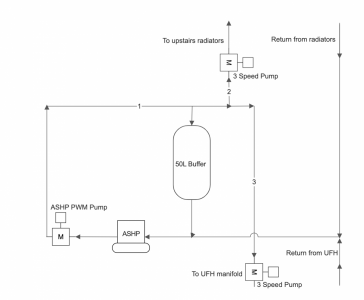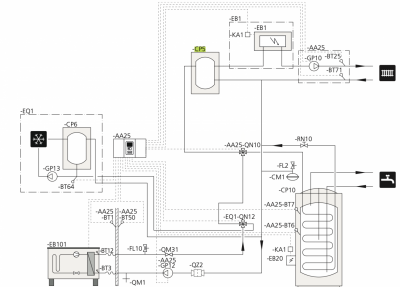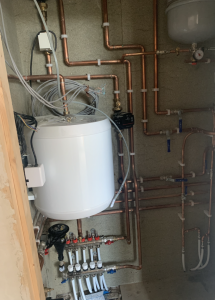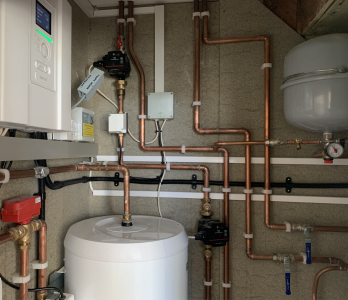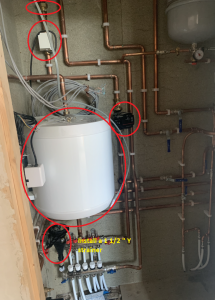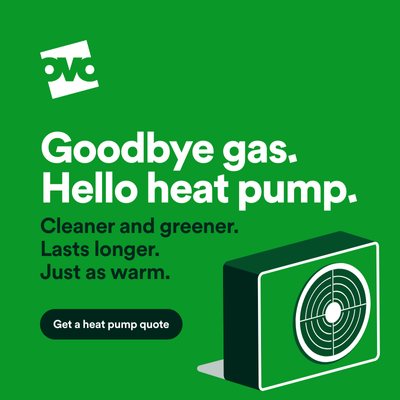Help me optimise my ASHP Pipework
I've got a Nibe F2040 ASHP which has been installed for over a year now.
Whilst trying to optimise the system I've wondered if the buffer is causing me issues.
See attached drawing of my system. I have noticed that the pipework at point '1' is cooler than at point '2' and '3'.
The PWM motor is controlled by the Heat Pump to maintain a deltaT and the other 2 pumps are fixed speed (currently setting 2).
Does anyone have any suggestions on how I can better match the circulation pumps to the HP, or how I can prevent the mixing in the buffer.
I'm tempted to ask my installer to add a couple of valves to the top and bottom of the buffer so I can try isolating this completely?
I would suggest that you check your schematic, since it appears to make little sense. A buffer tank would normally have at least 4 connections, 2 in and 2 out. I also don't understand why pipe '1' would be cooler than pipes '2' and '3', if the direction of flow is as shown.
There is often an arrow on the pump body to indicate the direction of flow.
The schematic is correct as drawn and the buffer is Tee'd off the pipework that then goes towards the other 2 pumps.
Apologies pipe '1' was meant to say warmer not cooler.
What is the temperature difference?
Looking at the schematic, I suspect that the combined flow rate through the two pumps on pipes '2' and '3' is greater than the pump on pipe '1'. This will probably have the effect of drawing the cooler water in the return pipe, through the buffer tank, and hence causing it to mix and cool the water from the heat pump. Try reducing the speed of the pumps on pipes '2' and '3' to see if this increases the temperature in the aforementioned pipes.
@luke remove the buffer and it will work properly. The schematic is not a Nibe 2040 configuration. There is no need for the buffer. If you have a blending valve and pump on your under floor manifold, this should be removed and, firstly, I would try to run the system on a single temperature with the internal sensor to control the house temperature, if that does not have adequate control, then set up 2 separate zones through the controller.
Posted by: @derek-mWhat is the temperature difference?
Looking at the schematic, I suspect that the combined flow rate through the two pumps on pipes '2' and '3' is greater than the pump on pipe '1'. This will probably have the effect of drawing the cooler water in the return pipe, through the buffer tank, and hence causing it to mix and cool the water from the heat pump. Try reducing the speed of the pumps on pipes '2' and '3' to see if this increases the temperature in the aforementioned pipes.
I have slowed the pumps down to speed 1 and will report back. I'm not sure of the temperature difference, but it was noticeable by hand. I have access to a thermal camera so I'll get hold of this.
Posted by: @heacol@luke remove the buffer and it will work properly. The schematic is not a Nibe 2040 configuration. There is no need for the buffer. If you have a blending valve and pump on your under floor manifold, this should be removed and, firstly, I would try to run the system on a single temperature with the internal sensor to control the house temperature, if that does not have adequate control, then set up 2 separate zones through the controller.
I agree that ultimately I want the buffer removed or at least put in series as I don't think it has any benefit and we should have sufficient volume in the circuits.
There is no blending valve on the UFH manifold and I run the whole system in WC using the internal sensor to 'adapt' the curve. All TRVS open and heating circulation pump thermostat set as a max stop limit only.
Looking at the below schematic, my system is I believe a similar setup to this, excluding CP6 and EB1 and any associated valves / pipework. CP5 is shown as the buffer vessel (which in my case is a Nibe UKV 20-40)
When looking at that installation manual for the UKV it doesn't actually show my configuration with the buffer, which I would say is different to the SMO20 installer manual screenshot?
Here are a couple of pictures of my setup before it was finished and insulated.
@luke Your valve is fine, remove the items circled and you will have very good performance. You have plenty of system volume for the heat pump.
@heacol thanks for this. I will take these comments back to my installer.
May I ask why you would remove the TF1 filter for a strainer? Is this just to improve flow? Will there be other detrimental effects?
Also I presume you are saying that the system will run from just the charge pump as you are suggesting removal of both heating medium circulation pumps. (I like this idea as it will reduce base load, but I expect my installer will be hesitant to recommend this considering he installed both!)
@luke TF1 filter for a strainer? Is this just to improve flow? Will there be other detrimental effects? just to improve flow and stop parasitic losses. It will have no detrimental effect. It can be put back in parallel with the strainer if you are worried.
The installer will probably balk at removing them, but you are the customer.
- 26 Forums
- 2,364 Topics
- 53.6 K Posts
- 47 Online
- 6,029 Members
Join Us!
Worth Watching
Latest Posts
-
-
RE: Octopus Cosy Heat Pump Owners & Discussion Thread
@kevh it's worth remembering that many lsvs only actual...
By JamesPa , 10 hours ago
-

@majordennisbloodnok Education, Education, Education…
By Toodles , 13 hours ago
-

RE: Setback savings - fact or fiction?
Exactly. We only need to compare conditions, to decide ...
By cathodeRay , 16 hours ago
-
RE: Balancing financial efficiency and comfort using the Octopus Cosy tariff
I found because I have very low heat loss I can set bac...
By RadWhisperer , 19 hours ago
-
RE: Need Help Optimising My Rushed ECO4 Install: 12kW Bosch Heat Pump
Welcome @mickamills We too have an oversized 12kW Sa...
By Old_Scientist , 1 day ago
-
RE: My Powerwall 3 Consumes 3-4 kWh/Day in Self-Consumption: Is This Normal?
@caron I can confirm that the power usage of the PW3 is...
By Old_Scientist , 1 day ago
-
RE: Speedcomfort radiator fans
Thats true, but having tried (and succeeded) in constru...
By JamesPa , 1 day ago
-
RE: Solis S6-EH1P8K-L-PLUS – Why I Chose It and What I’ve Learned So Far
@bash brilliant, thanks for the feedback
By energy9165 , 1 day ago
-

RE: Heat Pump Heats the House… But It’s Not Cosy. Emitter Changes or System Tweak?
@alastair There I was, feeling grumpy, he said “Cheer u...
By Toodles , 1 day ago
-
RE: Grant Aerona: Is there a setting to keep the 2-port valve open during pump blockade
Depends on OAT. Mine cycles at OAT>10 and of course...
By JamesPa , 1 day ago
-
RE: New Fogstar 15.5kWh upright solution
@transparent My conclusion is as you have noted, tha...
By Bash , 1 day ago
-
RE: Mitsubishi Ecodan R290 10kW performance
And to you too. Wishing you a very enjoyable festive s...
By Sheriff Fatman , 2 days ago
-

RE: External pipework insulation
They do? But that isn't apparent from the photos we'r...
By Transparent , 2 days ago
-

RE: Say hello and introduce yourself
@velcro welcome to the forums. Please feel free start a...
By Mars , 2 days ago
-
Daikin EDLA11D3V3 DHW Settings
I have a newly installed EDLA11D3V3 which I'm still get...
By Velcro , 2 days ago
-
RE: Midea ASHP – how to set weather compensation
@curlykatie did you get sorted with this?
By MickaMills , 2 days ago
-
RE: MyVaillant Connect Regular Disconnect
Thanks. Yes, if the time is consistently 11pm every nig...
By buckwem , 3 days ago

